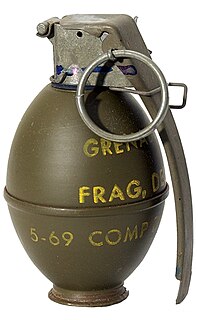
A grenade launcher is a weapon that fires a specially-designed large-caliber projectile, often with an explosive, smoke or gas warhead. Today, the term generally refers to a class of dedicated firearms firing unitary grenade cartridges. The most common type are man-portable, shoulder-fired weapons issued to individuals, although larger crew-served launchers are issued at higher levels of organisation by military forces.

"Mills bomb" is the popular name for a series of British hand grenades. They were the first modern fragmentation grenades used by the British Army and saw widespread use in the First World War.

The Mk 19 grenade launcher is an American 40 mm belt-fed automatic grenade launcher that was first developed during the Vietnam War. The first model in 1966 was determined to be unreliable and unsafe, but a total of six Mod 1 launchers were successfully tested on U.S. Navy riverine patrol craft in the Mekong Delta in 1972. The Navy made further improvements to the weapon, resulting in the Mod 3 in 1976. The Mod 3 was adopted by the U.S. Army in 1983 and remains in service to the present day.

The M79 grenade launcher is a single-shot, shoulder-fired, break-action grenade launcher that fires a 40×46mm grenade, which uses what the US Army calls the High-Low Propulsion System to keep recoil forces low, and first appeared during the Vietnam War. Because of its distinctive report, it has earned the nicknames of "Thumper", "Thump-Gun", "Bloop Tube", "Big Ed", "Elephant Gun," and "Blooper" among American soldiers as well as "Can Cannon" in reference to the grenade size; Australian units referred to it as the "Wombat Gun". The M79 can fire a wide variety of 40 mm rounds, including explosive, anti-personnel, smoke, buckshot, flechette, and illumination. While largely replaced by the M203, the M79 has remained in service in many units worldwide in niche roles.
A rifle grenade is a grenade that uses a rifle-based launcher to permit a longer effective range than would be possible if the grenade were thrown by hand.
The .30-06 Springfield cartridge, 7.62×63mm in metric notation and called ".30 Gov't '06" by Winchester, was introduced to the United States Army in 1906 and later standardized; it remained in use until the late 1970s. The ".30" refers to the caliber of the bullet in inches. The "06" refers to the year the cartridge was adopted, 1906. It replaced the .30-03, 6mm Lee Navy, and .30-40 Krag cartridges. The .30-06 remained the U.S. Army's primary rifle and machine gun cartridge for nearly 50 years before being replaced by the 7.62×51mm NATO and 5.56×45mm NATO, both of which remain in current U.S. and NATO service. It remains a very popular sporting round, with ammunition produced by all major manufacturers.

The GP-25 Kostyor ("Bonfire"), GP-30 Obuvka ("Footwear") and GP-34 are a family of Russian 40 mm under-barrel grenade launchers for the AK family of assault rifles. They were first seen by the west in 1984 during the Soviet Invasion of Afghanistan. The GP-30 was lightened and the redesigned sighting system was moved to the right.

The karabinek wzór 1988 Tantal is a 5.45×39mm assault rifle designed and produced in Poland in the late 1980s.
The SIG SG 510 or Sturmgewehr 57 is a selective fire battle rifle manufactured by Schweizerische Industrie Gesellschaft of Switzerland. It uses a roller-delayed blowback system similar to the H&K G3 and CETME rifles. The SIG SG 510-1 entered service in the Swiss Army with the designation Fass 57 or Stgw 57.

The XM307 Advanced Crew Served Weapon (ACSW) was a developmental 25 mm belt-fed automatic grenade launcher with programmable airburst capability. It is the result of the OCSW or Objective Crew Served Weapon project. It is lightweight and designed to be two-man portable, as well as vehicle mounted. The XM307 can kill or suppress enemy combatants out to 2,000 meters, and destroy lightly armored vehicles, watercraft, and helicopters at 1,000 meters. The project was canceled in 2007.
The Neopup PAW-20 is a grenade launcher designed by Tony Neophytou and as of 2015, is produced and marketed by Denel.
The MEI HELLHOUND 40 mm Low Velocity Multi-Purpose Grenade is a fixed type ammunition designed to be fired from a 40 mm Grenade Launcher such as the M79, M203, M320, or Milkor MK-1. The round consists of an A5 filled metal projectile body with a rotating band, a point initiating-base detonating fuze with Safe and Arm technology, and a cartridge case assembly. Upon impact with the target, the firing pin is driven into the detonator, which in turn initiates the spit backcharge, producing a jet which initiates the explosive train from the base forward, resulting in an armor-piercing jet of molten metal and fragmentation of the projectile body. The MEI Hellhound uses the same High-Low Propulsion System as other popular 40mm grenade launchers, which keeps the recoil forces in bounds for an infantry small arm.

The 22mm rifle grenade is inserted over the firing mechanism on the front of rifles that are equipped with the appropriate spigot-type launcher, either in the form of an integral flash suppressor or a detachable adapter. As with most rifle grenades, it is propelled by a blank cartridge inserted into the chamber of the rifle. A 22mm grenade can range from powerful anti-tank rounds to simple finned tubes with a fragmentation hand grenade attached to the end. The "22mm" refers to the diameter of the base tube which fits over the spigot of the launcher, not the diameter of the warhead section, which is much wider.
In military munitions, a fuze is the part of the device that initiates function. In some applications, such as torpedoes, a fuze may be identified by function as the exploder. The relative complexity of even the earliest fuze designs can be seen in cutaway diagrams.
The Dilagrama m/65 is a device employed by the Portuguese Army that fits G3 Automatic Rifles allowing them to launch defensive Type m/63 hand grenades further than they can be thrown by hand.

The APAV 40 is a 40 mm anti-personnel rifle grenade used by the French Army.
The High-Low system, also referred to as the "High-Low Pressure system", the "High-Low Propulsion System", and the "High-Low projection system", is a design of cannon and antitank launcher using a smaller high-pressure chamber for storing the propellant. It enables a much larger projectile to be launched without the heavy equipment typically required for large caliber weapons. When the propellant is ignited, the higher pressure gases are bled out through vents at reduced pressure to a much larger low pressure chamber to push the projectile forward. With the High-Low System a weapon can be designed with reduced or negligible recoil. The High-Low System also allows the weight of the weapon and its ammunition to be significantly reduced. Manufacturing cost and production time are drastically lower than for standard cannon or other small-arm weapon systems firing a projectile of the same size and weight. It has a far more efficient use of the propellant, unlike earlier recoilless weapons, where most of the propellant is expended to the rear of the weapon to counter the recoil of the projectile being fired.

The M31 HEAT is a fin-stabilized anti-tank rifle grenade designed in the late 1950s to replace the Belgian ENERGA rifle grenade which was adopted by the US Army and US Marines as an emergency stop-gap measure during the Korean War. Like the ENERGA, it has a nose-initiated, based-detonated HEAT warhead, but unlike the ENERGA, the mechanical impact fuse system is replaced with a less complex and more reliable piezo-electric fuse system which also allows higher angles of impact, up to 65 degrees. On impact, the nose cover collapses, crushing a crystal-like material, which sends an electric current through a separate wire to the warhead's detonator, located in the base of the warhead. A mechanical safety, comprising a set back system located in the warhead's base, grounds the firing circuit and prevents the accidental explosion of the warhead. On firing, the sudden launch acceleration causes the set-back's three disks to rotate 90 degrees, each in succession to the other, with the rotation of the third disk removing the grounding after approximately 10 meters of flight and completing a firing circuit for the current to flow from the nose to the detonator in the base. Compared to the ENERGA, the M31 is slightly lighter in weight and has a smaller-diameter warhead—i.e. 75mm vs 66mm. Penetration for the M31 is estimated to be 200 mm / 8 inches for steel armor plating and twice that estimate for concrete. The warhead technology developed for the M31 was used for the future M72 LAW antitank rocket.


















